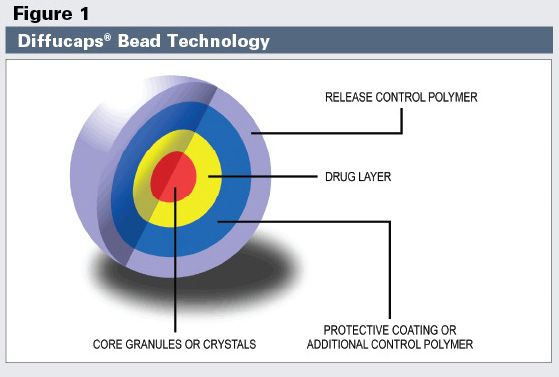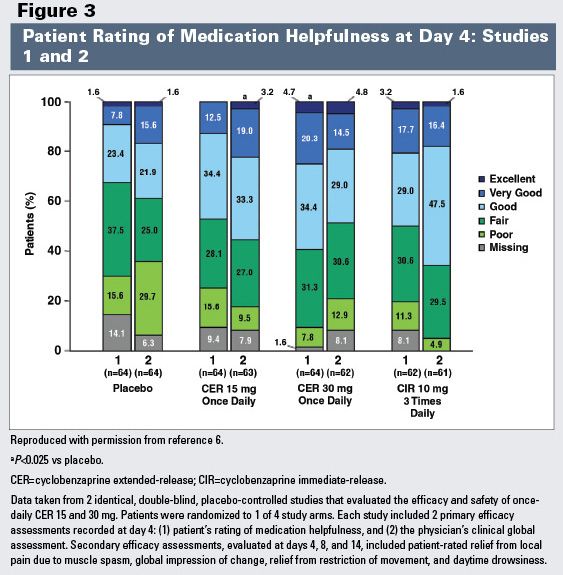Article
Cyclobenzaprine Extended-Release: The Difference Is in the Formulation
Author(s):
SPONSORED EDITORIAL
Arnold J. Weil, MD, MBA, a Diplomate of the American Board of Physical Medicine and Rehabilitation, is a clinical assistant professor of Rehabilitation Medicine at Emory University School of Medicine in Atlanta, Georgia. Dr. Weil also serves as the medical director of clinical research and chief executive officer at Non- Surgical Orthopaedics, P.C. in Atlanta, Georgia, where he has developed an international musculoskeletal and spine fellowship program focusing on diagnostic evaluation, injection procedures, and nonsurgical orthopaedic care.
This sponsored editorial is brought to you by Cephalon, Inc.
Cyclobenzaprine Extended- Release (CER) Capsules
Cyclobenzaprine extended-release (CER) capsules became available in 2007 under the brand name AMRIX® (Cephalon, Inc., Frazer, PA, USA). A skeletal muscle relaxant indicated as an adjunct to rest and physical therapy for relief of muscle spasm associated with acute, painful musculoskeletal conditions, CER is the only once-daily formulation of cyclobenzaprine available, and differs in important respects from its counterpart, cyclobenzaprine immediate- release (CIR), dosed 3 times daily.
CER employs Diffucaps® drug delivery technology (Eurand, Inc., Vandalia, OH, USA) to provide for a distinct pharmacokinetic profile.1 The formulation is designed to control the rate of diffusion and subsequent absorption of cyclobenzaprine, delivering early systemic exposure while producing more consistent levels in plasma than CIR over 24 hours.2 Most patients take CER 15 mg once daily, with the option to increase to 30 mg once daily, if necessary.
Cyclobenzaprine: A Historical Perspective
Cyclobenzaprine is not new to medicine, having been first synthesized almost 50 years ago. Experimental studies revealed that the drug had skeletal muscle relaxant effects; controlled trials confirmed its efficacy for relieving the signs and symptoms of acute muscle spasm of local origin. In 1977, cyclobenzaprine was approved by the FDA for its current indication. Today, skeletal muscle relaxants are widely prescribed, and good evidence supports their effectiveness in the treatment of acute low back pain.3,4
Until the advent of CER, cyclobenzaprine was only available in an immediate-release formulation, administered at intervals up to 3 times per day in 5- or 10-mg doses. Sedation was a widely reported side effect, with clinical studies having reported incidences of drowsiness of up to 39% with CIR.5
Diffucaps® Technology
Diffucaps, the delivery system used for CER, is a multiparticulate bead system made up of multiple layers of drug, excipients, and

release-controlling polymers (Figure 1). The beads can contain a layer of organic acid or alkaline buffer to control a drug's solubility by creating an optimal pH microenvironment. Alternatively, Diffucaps beads can contain a solid solution of drug and crystallization inhibitor to enhance bioavailability by maintaining the drug in its amorphous state.
The Diffucaps beads contained in each CER capsule are made by coating an inert core (such as sugar) with a layer of the active drug, cyclobenzaprine, and then by applying a seal coat and rate-controlling membrane. The beads are small, approximately 1 mm or less in diameter, and individual capsule shells are filled with sufficient quantity of these to yield a 15- or 30-mg dose of CER.
Pharmacokinetic studies have shown that once-daily CER provides controlled release of cyclobenzaprine and produces sustained levels in plasma over 24 hours, in contrast to the fluctuating "peaks and troughs" pharmacokinetic profile of CIR (Figure 2).1

The differences in the pharmacokinetic profiles of CER and CIR have also played out in clinical studies. The efficacy of CER has been shown to be similar to that of CIR. In a recently published study by Malanga et al, once-daily CER (15 and 30 mg) was effective at relieving acute muscle spasm after 4 days of treatment (Figure 3),6 a result consistent with earlier studies of CIR.7-16 Both CER and CIR were more effective than placebo, as reported by improvement in several efficacy measures, including patients' rating of medication helpfulness, relief from acute local pain due to muscle spasm, patient-rated global impression of change, and restriction of movement.6
It is in the adverse event profiles that a clinical difference can be seen between CER and CIR. In the clinical studies, patients receiving CER (15 and 30 mg) once daily tended to report fewer adverse events than patients receiving CIR (10 mg) taken 3 times daily. In particular, CER was associated with less somnolence than CIR and fewer discontinuations because of somnolence than CIR (Table).6
The decreased rates of somnolence with CER may be related to its unique pharmacokinetic profile. From a pharmacokinetic perspective, data have shown that steady-state plasma cyclobenzaprine levels are approximately 30% lower with CER 30 mg once daily than with CIR 10 mg 3 times daily (administered at 8-hour intervals).17 A further benefit may be realized by controlling the timing of administration. If CER is dosed in the early evening (between 6 and 7 pm, as was the case in the clinical studies), then peak concentrations should occur in the middle of the night (between midnight and 2 am). To the extent that adverse events such as somnolence are dose-related, as has been suggested for CIR16.patients would most likely be somnolent when plasma concentrations are highest, namely during sleeping hours.

Clinical studies represent a controlled environment, of course, and data cannot necessarily be extrapolated to clinical practice. In the studies reported by Malanga et al, the efficacy profiles of CER and CIR were similar, but CIR was taken 3 times daily in the context of the clinical study to achieve parity. In clinical practice, patients cannot or do not always adhere to a 3-times-daily regimen. Furthermore, physicians may instruct their patients to take only 1 dose of CIR at bedtime, to avoid troublesome adverse events (particularly somnolence) during the day. Although such a strategy may help patients to avoid daytime somnolence, reducing the dosing frequency of CIR could result in suboptimal efficacy, creating a potentially painful, untreated interval between doses.16 The end result could be a delay in the relief of muscle spasm, thereby prolonging muscle spasm and pain.
In summary, CER is the only extended-release formulation of cyclobenzaprine available. The Diffucaps technology makes once-daily dosing possible, which has been associated with an improved tolerability relative to CIR. The efficacy of CER and CIR has been shown to be similar in clinical studies; in clinical practice, however, only with CER can optimal efficacy be realized with a single daily dose.

References
1. Darwish M, Hellriegel ET, Xie F. Single-dose pharmacokinetics of once-daily cyclobenzaprine extended release 30 mg versus cyclobenzaprine immediate release 10 mg three times daily in healthy young adults: a randomized, open-label, two-period crossover, single-centre study. Clin Drug Investig. 2008;28(12):793-801.
2. Darwish M, Chang S, Hellriegel ET. A pharmacokinetic comparison of single doses of once-daily cyclobenzaprine extended-release 15 mg and 30 mg: a randomized, double-blind, two-period crossover study in healthy volunteers. Clin Ther. 2009;31(1):108-114.
3. Chou R, Huffman LH. Medications for acute and chronic low back pain: a review of the evidence for an American Pain Society/American College of Physicians clinical practice guideline. Ann Intern Med. 2007;147(7):505-514.
4. Chou R, Qaseem A, Snow V, et al. Diagnosis and treatment of low back pain: a joint clinical practice guideline from the American College of Physicians and the American Pain Society. Ann Intern Med. 2007;147(7):478- 491.
5. Flexeril (cyclobenzaprine hydrochloride tablets) Prescribing Information. Fort Washington, PA: McNeil Consumer and Specialty Pharmaceuticals; 2005.
6. Malanga GA, Ruoff GE, Weil AJ, et al. Cyclobenzaprine ER for muscle spasm associated with low back and neck pain: two randomized, double-blind, placebo-controlled studies of identical design. Curr Med Res Opin. 2009;25(5):1179-1196.
7. Bercel NA. Cyclobenzaprine in the treatment of skeletal muscle spasm in osteoarthritis of the cervical and lumbar spine. Curr Ther Res. 1977;22(4):462-468.
8. Aiken DW. A comparative study of the effects of cyclobenzaprine, diazepam and placebo in the treatment of acute musculoskeletal conditions of the low back. In: Clinical Evaluation of Flexeril (Cyclobenzaprine HCl/MSD). Minneapolis, MN: Postgraduate Medicine Communications; 1978:34-38.
9. Aiken DW. Cyclobenzaprine in the treatment of acute skeletal muscle spasm of local origin. In: Clinical Evaluation of Flexeril (Cyclobenzaprine HCl/MSD). Minneapolis, MN: Postgraduate Medicine Communications; 1978:30-33.
10. Bianchi M. Evaluation of cyclobenzaprine for skeletal muscle spasm of local origin. In: Clinical Evaluation of Flexeril (Cyclobenzaprine HCl/MSD). Minneapolis, MN: Postgraduate Medicine Communications; 1978:25-29.
11. Brown BR Jr, Womble J. Cyclobenzaprine in intractable pain syndromes with muscle spasm. JAMA. 1978;240(11):1151-1152.
12. Nibbelink DW, Strickland SC, McLean LF, Gould AL. Cyclobenzaprine, diazepam and placebo in the treatment of skeletal muscle spasm of local origin. Clin Ther. 1978; 1(6):409-424.
13. Scheiner JJ. Cyclobenzaprine in the treatment of local muscle spasm. In: Clinical Evaluation of Flexeril (Cyclobenzaprine HCl/MSD). Minneapolis, MN: Postgraduate Medicine Communications; 1978:39-48.
14. Steingard PM, Schildberg WL, Peterson KD. Multiclinic study of a muscle relaxant for treatment of acute musculoskeletal disorders. Osteopath Ann. 1980;8(10):44-58.
15. Baratta RR. A double-blind study of cyclobenzaprine and placebo in the treatment of acute musculoskeletal conditions of the low back. Curr Ther Res. 1982;32(5):646-652.
16. Borenstein DG, Korn S. Efficacy of a lowdose regimen of cyclobenzaprine hydrochloride in acute skeletal muscle spasm: results of two placebo-controlled trials. Clin Ther. 2003;25(4):1056-1073.
17. Altman CA, Hellriegel E, Darwish M. Rates of somnolence with cyclobenzaprine extendedrelease versus cyclobenzaprine immediaterelease [abstract]. J Med. 2009;2(3):3.
Acknowledgments ECR Pharmaceuticals, Richmond, VA, USA, sponsored the studies of CER reviewed in this article. Cephalon, Inc., Frazer, PA, USA, acquired the North American rights to CER (AMRIX) in August 2007. The author acknowledges Charles A. Altman, MD, MBA (Cephalon, Inc., Frazer, PA, USA), for providing a medical review of this article, and Jim Clevenger, PhD (Eurand, Inc.) for providing a synopsis of the Diffucaps drug delivery technology. Writing support for the preparation of this article was provided by Cephalon, Inc., Frazer, PA, USA, and editorial support was provided by Peloton Advantage, LLC, Parsippany, NJ, USA, funded by Cephalon, Inc. Funding for printing and distribution was provided by Cephalon, Inc., Frazer, PA, USA.
Newsletter
Stay informed on drug updates, treatment guidelines, and pharmacy practice trends—subscribe to Pharmacy Times for weekly clinical insights.






